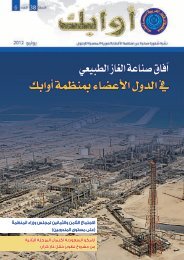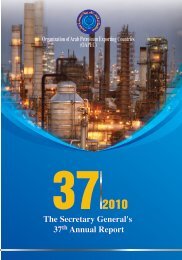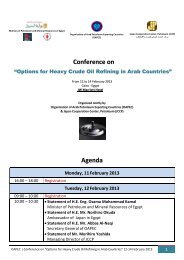- Page 2 and 3: ___________________________________
- Page 4 and 5: ___________________________________
- Page 6 and 7: Contents CONTENTS PREFACE .........
- Page 8 and 9: Contents 1. World Developments …
- Page 10 and 11: Contents 3-14 Paper Entitled “Pet
- Page 12 and 13: Contents TABLES PART ONE CHAPTER ON
- Page 14 and 15: Contents 2-13 Installed Wind Power
- Page 16 and 17: Contents 1-24 Energy Consumption in
- Page 18 and 19: PREFACE As the thirty-sixth Report
- Page 20 and 21: PART ONE INTERNATIONAL DEVELOPMENTS
- Page 24 and 25: 1-1 Non-OPEC Supplies Non-OPEC oil
- Page 26 and 27: The developing countries maintained
- Page 28 and 29: Figure 1-6 Distribution of World Oi
- Page 30 and 31: Demand in the Asian developing coun
- Page 32 and 33: • Organization of Petroleum Expor
- Page 34 and 35: Algerian crude fell by $37.9/b or 3
- Page 36 and 37: decrease occurred in US market, whe
- Page 38 and 39: Since 2004, the US Administration h
- Page 40 and 41: countries in particular. The latest
- Page 42 and 43: The second group comprises four cou
- Page 44 and 45: Figure 1-17 Per Capita Energy Consu
- Page 46 and 47: Figure 1-20 Oil Consumption in the
- Page 48 and 49: 2. Total Energy Consumption in OAPE
- Page 50 and 51: to 48.3% in 2009. The share of hydr
- Page 52 and 53: • Countries that depend on natura
- Page 54 and 55: PART ONE TABLES OF CHAPTER ONE DEVE
- Page 56 and 57: Table 1-2 Growth in the World Econo
- Page 58 and 59: Table 1-4 Total & Annual Change in
- Page 60 and 61: Table 1-6 Total & Annual Change in
- Page 62 and 63: Table 1-8 Total & Annual Change in
- Page 64 and 65: Table 1-10 Average Spot Prices of t
- Page 66 and 67: Table 1-12 Average Monthly Market S
- Page 68 and 69: Table 1-14 Spot Tanker Freight Rate
- Page 70 and 71: Table 1-16 Value of Oil Exports in
- Page 72 and 73:
Table 1-18 Energy Consumption in th
- Page 74 and 75:
Table 1-20 Energy Consumption in OA
- Page 76 and 77:
Table 1-22 Petroleum Products' Cons
- Page 78 and 79:
Table 1-24 Hydroelectricity Consump
- Page 80 and 81:
Table 1-26 Domestic Prices of Petro
- Page 82 and 83:
PART ONE CHAPTER TWO & CHAPTER THRE
- Page 84 and 85:
The size of petroleum companies’
- Page 86 and 87:
In Kingdom of Bahrain, a developmen
- Page 88 and 89:
On the other hand, Hayan oil and ga
- Page 90 and 91:
This agreement is the second of its
- Page 92 and 93:
Figure C Water Depth of Some Offsho
- Page 94 and 95:
In Republic of Iraq, Gulf Keystone
- Page 96 and 97:
The ministry of Oil and Mineral Res
- Page 98 and 99:
In Iraq, the Ministry of Oil, tied
- Page 100 and 101:
A drop by 14% was witnessed in Euro
- Page 102 and 103:
2. Oil and Natural Gas Reserves Est
- Page 104 and 105:
eserves were estimated at 20.35 bil
- Page 106 and 107:
showing an increase of about 8.6%,
- Page 108 and 109:
from 462.4 thousand b/d in 2008, to
- Page 110 and 111:
Figure 2-12 Marketed Natural Gas by
- Page 112 and 113:
in the quantities of natural gas ma
- Page 114 and 115:
(81%), Australia (80.0%), China (78
- Page 116 and 117:
power plant in the country, the fir
- Page 118 and 119:
2. Wind Energy 2-1 Wind Energy in t
- Page 120 and 121:
The United States of America came i
- Page 122 and 123:
4-2 Geothermal Energy in the Arab C
- Page 124 and 125:
PART ONE TABLES OF CHAPTER TWO ARAB
- Page 126 and 127:
Table 2-2 Average Number of Active
- Page 128 and 129:
Table 2-4 Arab and World Oil Reserv
- Page 130 and 131:
Table 2-5 Arab and World Natural Ga
- Page 132 and 133:
Table 2-6 Arab and World Hydrocarbo
- Page 134 and 135:
Table 2-7 NGL Production in OAPEC M
- Page 136 and 137:
Table 2-8 Cont. 2005 2006 2007 2008
- Page 138 and 139:
Table 2-10 World Coal Production, 2
- Page 140 and 141:
Table 2-11 Cont. Country Reactors i
- Page 142 and 143:
Table 2-13 Installed Wind Power Cap
- Page 144 and 145:
Table 2-15 Installed Geothermal Cap
- Page 146 and 147:
CHAPTER THREE ARAB AND WORLD DEVELO
- Page 148 and 149:
Figure 3-2 World Primary Distillati
- Page 150 and 151:
Figure 3-5 World Catalytic Cracking
- Page 152 and 153:
came Western Europe with 1,180 tons
- Page 154 and 155:
Despite the decision in some Arab c
- Page 156 and 157:
In Saudi Arabia, there was a delay
- Page 158 and 159:
Iranian National Petrochemical Comp
- Page 160 and 161:
In Iran, ethylene production capaci
- Page 162 and 163:
2. Arab Developments 2-1 Algeria Al
- Page 164 and 165:
Samsung will undertake to construct
- Page 166 and 167:
NATURAL GAS CONSUMPTION, TRADE AND
- Page 168 and 169:
1-2 Natural Gas Trade The volume of
- Page 170 and 171:
Natural gas exports from Arab count
- Page 172 and 173:
At the same time, the kingdom is st
- Page 174 and 175:
2-7 Qatar Qatar has been the world
- Page 176 and 177:
2-12 Yemen In August 2009, the natu
- Page 178 and 179:
PART ONE TABLES OF CHAPTER THREE AR
- Page 180 and 181:
Table 3-2 World Catalytic Conversio
- Page 182 and 183:
Table 3-4 World Coke Production Cap
- Page 184 and 185:
Table 3-6 Installed Refining Capaci
- Page 186 and 187:
ojects in OAPEC Member Countries
- Page 188 and 189:
ion Projects in Other Arab Countrie
- Page 192:
Table 3-10 World Ethylene Capacity
- Page 196:
Table 3-11 Cont. Country 2007 2008
- Page 201:
Table 3-13 Consumption of Natural G
- Page 206 and 207:
Table 3-15 Natural Gas Exports by R
- Page 208:
Table 3-17 Arab Natural Gas Exports
- Page 213 and 214:
PART TWO OAPEC ACTIVITIES IN 2009 C
- Page 215 and 216:
1-3 Workshop on Data Bank In implem
- Page 217 and 218:
2-4 Current Awareness and Lending -
- Page 219 and 220:
oil production. They also played an
- Page 221 and 222:
asic petrochemicals pattern toward
- Page 223 and 224:
Section four consists of two chapte
- Page 225 and 226:
paper pointed out the most importan
- Page 227 and 228:
- Difficulties encountered the impl
- Page 229 and 230:
The lectures covered technical, eco
- Page 231 and 232:
possibility of cooperation in natur
- Page 233 and 234:
4- Amendment of the Arab Investment
- Page 235 and 236:
2-6 Committee Meeting for Instituti
- Page 237 and 238:
Republic of Djibouti, in addition t
- Page 239 and 240:
2-13 5 th International Conference
- Page 241 and 242:
- Integrated techniques. - Other to
- Page 243 and 244:
mobilizing jointly US$100 billion d
- Page 245 and 246:
included the Arab Center for Educat
- Page 247 and 248:
Table 5-1 Publications Issued and D
- Page 249 and 250:
Table 5-3 General Secretariat Actua
- Page 251 and 252:
It should be emphasized here, that
- Page 253 and 254:
Despite the extraordinary efforts t
- Page 255 and 256:
- 22 vessels in the yard simultaneo
- Page 257 and 258:
As a result the production of the u
- Page 259 and 260:
Project Finance and Foreign Trade T
- Page 261 and 262:
market. In the past, the number of
- Page 263 and 264:
Dinar. This comprised 10% or LYD 13
- Page 265 and 266:
- A new rig of 2000 hp from the Kuw
- Page 267 and 268:
logging and perforation operations,
- Page 269 and 270:
The Arab Petroleum Services Company
- Page 271 and 272:
At the end of the first half of 200
- Page 273 and 274:
Financial Results in the First Half
- Page 275 and 276:
The Council then awarded prizes to
- Page 277 and 278:
II. MEETINGS AND SEMINARS SPONSORED
















